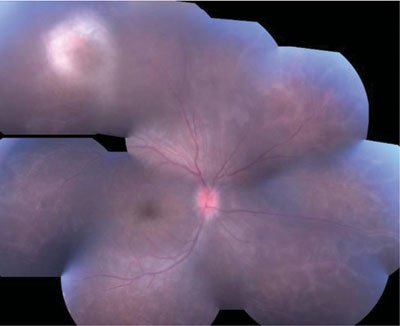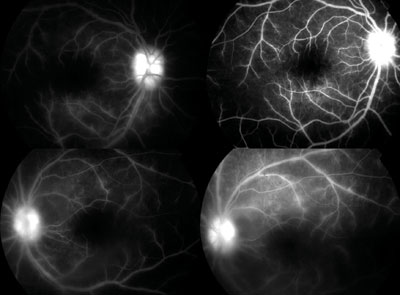Patient complains of a gradual decrease in vision in both eyes
The right eye had a patch of retinitis. Both eyes had leakage from the discs, diffuse leakage from the retinal vessels and staining of the retinal vessel walls.
 Mark E. Patron |
 Andre J. Witkin |
A 21-year-old African-American man initially presented to an outside optometrist who referred the patient to our eye clinic after he was unable to refract the patient to improve his vision.
On presentation to our clinic, the patient noted a gradual decrease in vision over the past month, the right eye more than the left. He also noted occasional brief flashes of light in both eyes and floaters in both eyes for the same amount of time. There was no pain in either eye. The patient was a college student and noted no significant medical or ocular history.
Examination
On examination, the patient’s best corrected visual acuity was 20/70 in the right eye and 20/30 in the left. IOPs were 13 mm Hg in the right eye and 16 mm Hg in the left. Anterior segment exam showed white conjunctivae, fine inferior keratic precipitates and 2+ anterior chamber cells in both eyes. Pupillary exam was normal with no afferent pupillary defect.
Dilated funduscopic examination revealed 3+ vitritis in the right eye and 2+ in the left, moderate optic nerve head edema in both eyes and diffuse vascular sheathing throughout the fundus of both eyes. In the right eye, there was a ring-shaped patch of retinitis in the superotemporal quadrant (Figure 1). Fluorescein angiography revealed leakage from both discs, diffuse leakage from the retinal vessels and staining of the retinal vessel walls in both eyes (Figure 2).
 Figure 1. Fundus photograph of the right eye taken at initial presentation, showing a hazy ocular medium due to vitritis, optic nerve head edema, diffuse vascular sheathing and a ring-shaped area of retinitis superotemporally. |
 Figure 2. Fluorescein angiograms from both eyes, revealing leakage from both discs, diffuse leakage from the retinal vessels and staining of the retinal vessel walls (frosted branch angiitis). |
 Figure 3. Photograph of the patient’s foot, showing a maculopapular rash over the sole. Images: Witkin AJ, Reichel E
|
Further history
On further review of systems, the patient noted no joint pain, fever, cough, oral ulcers or shortness of breath. He did note a maculopapular rash on his feet for 1 month (Figure 3). He had had a normal physical examination 3 months prior, with negative testing for sexually transmitted diseases, including HIV. He stated that he was sexually active, had seven female sexual partners and had used condoms each time.

What is your diagnosis?
Frosted branch angiitis and retinitis
This patient presented with bilateral panuveitis, frosted branch angiitis and a single patch of retinitis. The differential diagnosis of a patient with frosted branch angiitis and retinitis includes toxoplasmosis, herpes viruses, Lyme disease, syphilis, tuberculosis, sarcoidosis, Behçet’s disease, lymphoma and leukemia.
Differential diagnosis
Primary toxoplasmosis may appear as a patch of retinitis, with frosted branch angiitis and overlying vitritis, without the pathognomonic chorioretinal scar seen in secondary toxoplasmosis. The disease is usually monocular. Cytomegalovirus retinitis typically occurs in immunocompromised patients and usually presents initially in one eye, with a predominant “pizza pie” appearance due to hemorrhage and retinal whitening. Retinitis from other viruses in the herpes virus family typically has associated vasculitis; the lesions start peripherally in immunocompetent patients, but may be more posterior and with less inflammation in immunocompromised patients. Ocular Lyme most commonly presents as intermediate uveitis, but a variety of other manifestations have been reported. Tuberculosis also may mimic a variety of ocular syndromes. An immune reaction to tuberculin protein may cause bilateral retinal vascular sheathing and vascular occlusion (Eales disease). Tuberculosis should be suspected in patients from high-risk areas who present with uveitis. Syphilis is another “great masquerader” in eye disease and should always be considered in any case of uveitis. It is one of the few diseases that may cause both arterial and venous retinal vasculitis. Secondary syphilis is also one of the few systemic diseases that causes a maculopapular rash on the soles of the feet and the palms of the hands.
Several inflammatory diseases may also cause retinal vasculitis. Behçet’s disease can mimic infectious retinitis, and a history of mucous membrane ulceration should be obtained in patients with posterior uveitis. Systemic lupus erythematosus is another of the few causes of simultaneous arterial and venous retinal vasculitis. Sarcoidosis may cause retinal vasculitis, but usually affects the retinal veins preferentially; associated perivenous exudates are often referred to as “candle-wax drippings.” Lymphoma may presents as chronic vitritis with associated retinal vasculitis; this disease is more common in older patients. Leukemia commonly has other pathognomonic systemic manifestations and often presents with vascular occlusive disease.
Clinical course
The day of presentation, the patient was sent for multiple blood tests, including CBC, ACE, ESR, UA, ANA, ANCA, RPR, FTA-ABS, HIV, Lyme titers and Toxo titers, and a chest X-ray. Positive testing was discovered, including +RPR with titers greater than 1:1024, +FTA-ABS and +HIV testing (confirmed with Western blot). A diagnosis of ocular syphilis was made, and the patient was strongly encouraged to come to the hospital for treatment.
The patient returned to the eye clinic 2 weeks after the initial visit. At that time, his vision had dropped to hand motions in the right eye, with increased pain and redness, and severe vitritis with no clear view to the retina. The left eye had remained stable. The patient was immediately admitted to the infectious disease service for treatment with IV aqueous penicillin VK 4 million units q4h (the treatment dose for neurosyphilis). A lumbar puncture was performed and showed 148 WBC, 1 RBC, 90% lymphocytes, 124 protein and 32 glucose. The CD4 count was found to be 238, and HIV viral load was 50982. The patient was then sent home with a PICC line to continue a 2-week regimen of IV penicillin. Topical prednisolone acetate and cyclopentolate were started in both eyes. An oral prednisone taper was also started at 60 mg/day.
After 2 weeks of treatment, the vision had improved to 20/200 in the right eye and 20/25 in the left, with a clearer view to the fundus in the right eye and much improved inflammation in the left eye.
Discussion
Syphilis was once a prevalent disease, but with the advent of penicillin, syphilis rates dramatically declined. In the early 1990s, another drop in syphilis rates occurred with the onset of the HIV epidemic and its associated increase in contraception use. However, over the past decade, syphilis rates have been slowly increasing, likely due to the increasing perception of HIV as a treatable and chronic illness. In the United States, most of this increase has been in homosexual men; other demographics have, in fact, had a decline in syphilis rates during this time. Up to 50% of patients with syphilis have a co-infection with HIV; therefore, every patient with syphilis should be tested for HIV.
As with other spirochete illnesses, syphilis infection progresses through a number of stages. Primary syphilis presents with a chancre at the inoculation site, which disappears after 1 month. Secondary syphilis appears 4 to 10 weeks after initial manifestation, at which point the patient has his highest systemic bacterial load. A maculopapular rash is characteristic, constitutional symptoms are often present, and ocular involvement is most common at this stage (10% of cases), often presenting as uveitis (as in our patient). Most secondary cases convert to latent syphilis and remain latent; however, 30% go on to develop tertiary syphilis, which presents with usually benign gummatous lesions. However, cardiovascular gummas can involve coronary arteries or the aorta, and central nervous system gummas, or neurosyphilis, may manifest with tabes dorsalis or general paresis.
Syphilitic uveitis is typically a complication of secondary syphilis. The inflammation may or may not be granulomatous. Posterior uveitis is most common and includes vitritis, retinal vasculitis, chorioretinitis and papillitis. The retinal vasculitis may affect all retinal vessels (both arteries and veins). Placoid macular chorioretinitis is characteristic in those who are HIV-positive. Late-stage disease, or tertiary syphilis, may be represented by optic atrophy and/or a pseudoretinitis pigmentosa picture.
Treatment of ocular syphilis is that of neurosyphilis. CSF sampling is suggested to monitor response to treatment (recheck every 6 months until negative). Oral steroid is often used to decrease ocular inflammation and to avoid Jarisch-Herxheimer reaction. IV penicillin for 10 to 14 days is recommended. Many suggest penicillin desensitization in penicillin-allergic patients, particularly HIV-positive patients.
Summary
This is a case of a 21-year-old patient who presented with bilateral panuveitis with frosted branch angiitis and a single patch of retinitis. Testing revealed concurrent infection with HIV and syphilis. He was treated with high-dose IV penicillin (neurosyphilis dose) and an oral steroid taper. He will be followed closely in the ophthalmology and infectious disease clinics.
References:
- Abu El-Asrar AM, Herbort CP, Tabbara KF. Retinal vasculitis. Ocul Immunol Inflamm. 2005;13(6):415-433.
- Anderson AM, Bergstrom CS. Syphilitic frosted branch angiitis with anterior uveitis in a patient with a new HIV diagnosis. Lancet Infect Dis. 2009;9(7):453.
- Chao JR, Khurana RN, Fawzi AA, Reddy HS, Rao NA. Syphilis: reemergence of an old adversary. Ophthalmology. 2006;113(11):2074-2079.
- Doris JP, Saha K, Jones NP, Sukthankar A. Ocular syphilis: the new epidemic. Eye (Lond). 2006;20(6):703-705.
- Gass JD, Braunstein RA, Chenoweth RG. Acute syphilitic posterior placoid chorioretinitis. Ophthalmology. 1990;97(10):1288-1297.
- Kiss S, Damico FM, Young LH. Ocular manifestations and treatment of syphilis. Semin Ophthalmol. 2005;20(3):161-167.
- Tran TH, Cassoux N, Bodaghi B, Fardeau C, Caumes E, Lehoang P. Syphilitic uveitis in patients infected with human immunodeficiency virus. Graefes Arch Clin Exp Ophthalmol. 2005;243(9):863-869.
- Walker S, Iguchi A, Jones NP. Frosted branch angiitis: a review. Eye (Lond). 2004;18(5):527-533.
- Wickremasinghe S, Ling C, Stawell R, Yeoh J, Hall A, Zamir E. Syphilitic punctate inner retinitis in immunocompetent gay men. Ophthalmology. 2009;116(6):1195-1200.
- Andre J. Witkin, MD, and Elias Reichel, MD, can be reached at New England Eye Center, Tufts University School of Medicine, 750 Washington St., Box 450, Boston, MA 02111; 617-636-4219; fax: 617-636-4866; Web site: www.neec.com.
- Edited by Mark E. Patron, MD, and Andre J. Witkin, MD. Drs. Patron and Witkin can be reached at New England Eye Center, Tufts University School of Medicine, 750 Washington St., Box 450, Boston, MA 02111; 617-636-4219; fax: 617-636-4866; Web site: www.neec.com.

